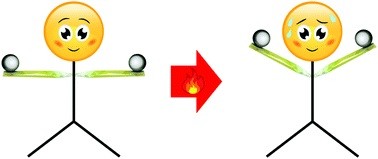Jumping crystals could be exploited in electronics

Scientists at The University of Texas at Dallas have observed unusual behaviour in a sample of crystals, in a study published in the journal Chemical Communications.
As part of her doctoral research, graduate student Madushani Dharmarwardana was investigating how the material, from a family of organic semiconducting materials called naphthalene diimides, changes colour from orange to yellow as it is heated.
“We were looking at this material as a thermochromic semiconductor,” said Dr Jeremiah Gassensmith, Dharmarwardana’s supervisor. “These types of semiconducting materials change colour as temperature changes. Think of beer cans that change colour when they’re cold or colour-changing thermometer strips you put on your forehead to check for fever.”
As Dharmarwardana heated the tiny crystals — only about a couple of millimetres in size — she noticed that they would move, which was unexpected. According to Dr Gassensmith, “The crystals would bend, coil, flex or jump — they would do all sorts of things.”
Although such thermosalient behaviour — also known as the jumping crystal effect — has been observed in other types of crystals, it had not been observed in this particular class of organic semiconducting crystals, Dr Gassensmith said. Such behaviour is of interest to researchers because it might be exploited for applications such as micromachines, sensors or tiny actuators for medical devices and artificial muscles.
Dharmarwardana decided to conduct a new set of experiments in which she glued down one end of the crystal to a glass cover slip and placed the slip on a hot plate. She revealed, “As the plate heated up, the crystal always tried to bend away from the heat.
“The explanation for this is that once the crystal reaches a certain temperature, the arrangement of molecules within the crystal changes. Those changes move sequentially through the material, starting at the hot part that’s stuck to the surface and propagating out. This causes the crystal to change shape.”
“We see colossal expansion in these materials, almost 20% in size,” Dr Gassensmith said. “That’s among the largest percentage change seen in an organic material.”
In her next set of experiments, Dharmarwardana glued tiny stainless steel balls to the anchored crystals to see how much weight the crystal cantilevers could lift as they were heated. Because the crystals are brittle, she expected them to break under the load.
“It amazed me when I saw it was actually lifting the ball because the crystal is very small compared to the weight, which was almost 100 times heavier than the crystal,” Dharmarwardana said. “When I designed the experiment, I never thought it would lift up. I thought it would break the crystal.”
The maximum load lifted with a 3.5 mm-long crystal cantilever was about 4 mg, to a height of 0.24 mm.
As the crystal cooled, it lowered and became straight once more. While reheating the material did not result in another shape change, the material continued to change colour with repeated temperature changes.
“This isn’t a reversible transformation,” Dr Gassensmith said. “Basically, the crystal starts out loaded with the potential energy to change shape and carry out the motion, but it holds on to that energy until the material reaches a phase transition temperature. At that point, the crystal wants to release this energy. If it is not bound to anything, the crystal will just pop or curl, but by fixing it on one end, we can direct how that energy is released.
“It’s still a single crystal, but its molecules are now in a different packing arrangement that has a lower energy.”
Dr Gassensmith said the next step is to further investigate different variations of the material, including whether the bending behaviour of the materials can be incorporated into colour-changing sensors or act as a mechanical breaker inside organic electronics.
“It will be interesting to see whether we can induce curling in these crystals electronically,” he said. “In principle, we should be able to apply an electric current to lift things, instead of using a bunch of heaters.”
The researchers have filed a patent and are pursuing licensing opportunities for the technology for commercial applications.
Novel antenna tech developed for 6G communications
Researchers have developed a novel metasurface antenna that can generate and control multiple...
Eliminating 'efficiency droop' for brighter LEDs
Researchers have found a way to make LEDs brighter while maintaining their efficiency for...
3D semiconductor chip alignment boosts performance
Researchers have developed an ultra-precise method to align 3D semiconductor chips using lasers...






